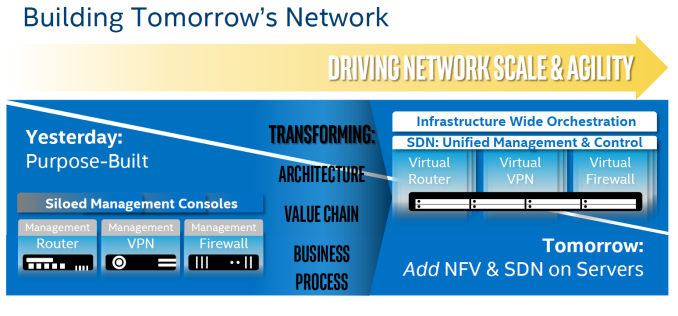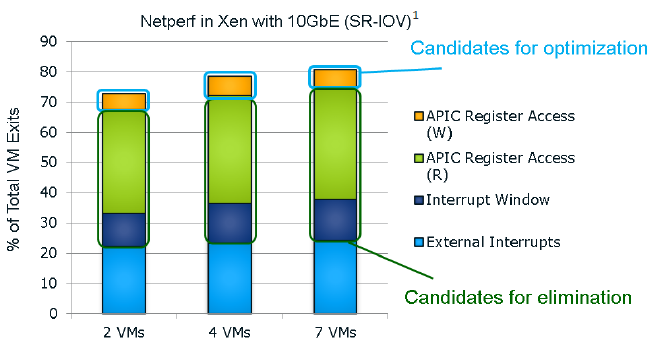The Intel Xeon E5 v4 Review: Testing Broadwell-EP With Demanding Server Workloads
by Johan De Gelas on March 31, 2016 12:30 PM EST- Posted in
- CPUs
- Intel
- Xeon
- Enterprise
- Enterprise CPUs
- Broadwell
TSX
TSX or Transactional Synchronization Extensions is Intel's cache-based transactional memory system. Intel launched TSX with Haswell, but a bug threw a spanner in the works. Broadwell in turn got it right. The chicken is finally there, now it's time to enjoy the eggs.
Faster Virtualization
Virtualization overhead is (for most people) a thing of the past. The performance overhead with bare metal hypervisors (ESXi, Hyper-V, Xen, KVM..) is less than a few percent. There is one exception however: applications where I/O dominates. And of course, the packet switching telco applications are the prime examples. Intel, VMware and the server vendors really want to convert the telcos from their Firewall/Router/VPN "black boxes" to virtual ones using Software Defined Networking (SDN) infrastructure. To that end, Intel has continued to work on reducing the virtualization performance overhead. Virtualization overhead can be described as the number of VM exits (VM stops and hypervisor takes over) times the VM exit latency. In IO intensive application, VM exits happen frequently, which in turn leads to hard to predict and high IO latency, exactly what the telco people hate.
Intel wants to conquer the telco's datacenter by turning it into a SDN
So Intel worked on both factors. So Broadwell-DP VM exit latency is once again reduced from 500 cycles to 400.
It seems that the "ticks" also get a VM exit reduction. This slide of the Ivy Bride EP presentation gives you a very good overview of the VM exits in a network intensive application; in this case a networkd bandwidth benchmark application.
I quote from our Ivy Bridge-EP review:
The Ivy Bridge core is now capable of eliminating the VMexits due to "internal" interrupts, interrupts that originate from within the guest OS (for example inter-vCPU interrupts and timers). The virtual processor will then need to access the APIC registers, which will require a VMexit. Apparently, the current Virtual Machine Monitors do not handle this very well, as they need somewhere between 2000 to 7000 cycles per exit, which is high compared to other exits.
The solution is the Advanced Programmable Interrupt Controller virtualization (APICv). The new Xeon has microcode that can be read by the Guest OS without any VMexit, though writing still causes an exit. Some tests inside the Intel labs show up to 10% better performance.
In summary, Intel eliminated the green and dark blue components of the VM exit overhead with APICv. Broadwell now takes on the VM exits due to the external interrupts.
The technology on Broadwell-EP to do this is called posted interrupt. Essentially, posted interrupts enables direct interrupt delivery to the virtual machine without incurring a VM exit, courtesy of an interrupt remapping table. It is very similar to VT-D, which allowed DMA remapping thanks to the physical to virtual memory mapping table. Telco applications - among others - are very latency sensitive. Intel's Edwin Verplancke gave us one such example: before posted interrupts, a telco application had a latency varying from 4 to 47 (!) µsec, depending on the load. Posted interrupts made this a lot less variable, and latency varied from 2.4 to 5.2 µsecs.
As far as we are aware, KVM and Xen seem to have already implemented support for posted interrupts.













112 Comments
View All Comments
patrickjp93 - Friday, April 1, 2016 - link
Knight's Landing: 730 mm^2, also on the 14nm platformextide - Friday, April 1, 2016 - link
Is it really that big..? Wow, I knew it was big, but didn't know it was that big. Got a source on that?Kevin G - Friday, April 8, 2016 - link
I'll second a link for a source. I knew it'd be big but that big?extide - Friday, April 1, 2016 - link
I know you meant Reticle, but that was a pretty funny typo, heh.Kevin G - Friday, April 8, 2016 - link
Autocorrect has gotten the best of me yet again.extide - Friday, April 1, 2016 - link
And, I know how big GM200 and Fiji are, but I am talking about big GPU's on 14/16nm. All signs are currently pointing to <300mm^2 for the first round of 14/16nm GPU's.lorribot - Thursday, March 31, 2016 - link
Given the way Microsoft and others are now licensing by the core and in large non splitable packages (Windows 2016 Datacenter is in blocks of 16 cores, a dual socket server with 44 cores would need 48 core licences) the increasing core count has limited appeal over small numbers of faster cores when looking at virtualised environments.Those still in the physical world will still have to pay per core but may have to buy 4 std Windows licenses.
when it comes to doing your testing, it should reflect these costs and compare total bang per buck when dealing with performance.
Red Hat still licences per socket but don't be surprised if they go per core too.
JohanAnandtech - Friday, April 1, 2016 - link
Back in 2008, I had a sales person explaining the license models of Microsoft to me in our lab. From that point on, we have invested most of our time and resources in linux server software. :-Dextide - Friday, April 1, 2016 - link
Enterprise linux isn't free, either ya knowrahvin - Friday, April 1, 2016 - link
Support isn't free on the FOSS side but the software is. Redhat is never going to charge more per "cores" for support, that's ridiculous and would result in rivals stealing their support contracts. If licensing costs are that bad that you are dumping hardware you really should be looking at moving services to Linux and Visualizing the windows servers so you can limit the core count and provide more horsepower.Anyone putting Microsoft on bare hardware these days is nuts. Although the consolation is that they get to pay MS's exorbitant tax on software. Linux should be the core component of any IT services and virtualized servers where you need proprietary server software.